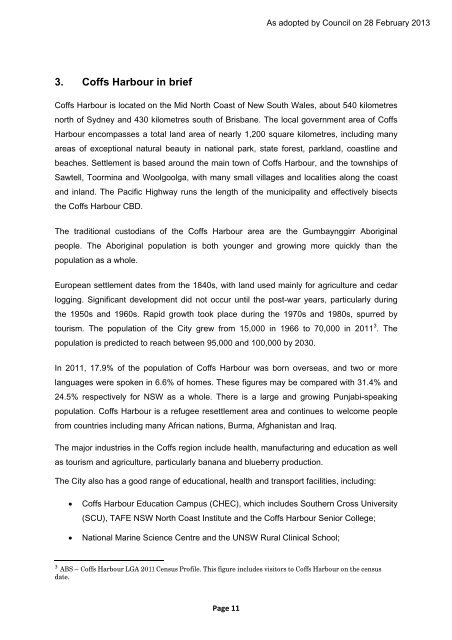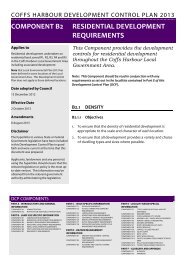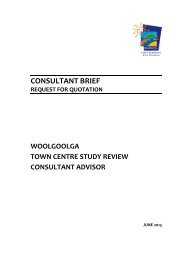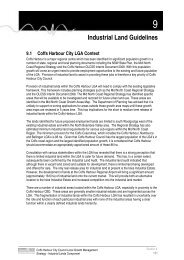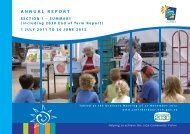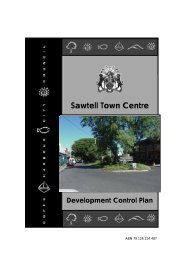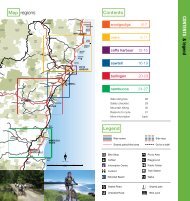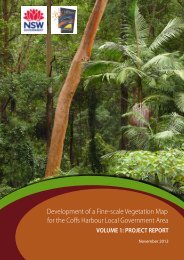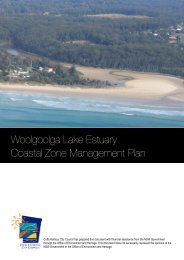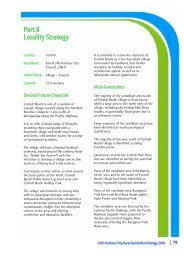Cultural Plan 2013-2016 final.pdf - Coffs Harbour City Council ...
Cultural Plan 2013-2016 final.pdf - Coffs Harbour City Council ...
Cultural Plan 2013-2016 final.pdf - Coffs Harbour City Council ...
You also want an ePaper? Increase the reach of your titles
YUMPU automatically turns print PDFs into web optimized ePapers that Google loves.
As adopted by <strong>Council</strong> on 28 February <strong>2013</strong><br />
3. <strong>Coffs</strong> <strong>Harbour</strong> in brief<br />
<strong>Coffs</strong> <strong>Harbour</strong> is located on the Mid North Coast of New South Wales, about 540 kilometres<br />
north of Sydney and 430 kilometres south of Brisbane. The local government area of <strong>Coffs</strong><br />
<strong>Harbour</strong> encompasses a total land area of nearly 1,200 square kilometres, including many<br />
areas of exceptional natural beauty in national park, state forest, parkland, coastline and<br />
beaches. Settlement is based around the main town of <strong>Coffs</strong> <strong>Harbour</strong>, and the townships of<br />
Sawtell, Toormina and Woolgoolga, with many small villages and localities along the coast<br />
and inland. The Pacific Highway runs the length of the municipality and effectively bisects<br />
the <strong>Coffs</strong> <strong>Harbour</strong> CBD.<br />
The traditional custodians of the <strong>Coffs</strong> <strong>Harbour</strong> area are the Gumbaynggirr Aboriginal<br />
people. The Aboriginal population is both younger and growing more quickly than the<br />
population as a whole.<br />
European settlement dates from the 1840s, with land used mainly for agriculture and cedar<br />
logging. Significant development did not occur until the post-war years, particularly during<br />
the 1950s and 1960s. Rapid growth took place during the 1970s and 1980s, spurred by<br />
tourism. The population of the <strong>City</strong> grew from 15,000 in 1966 to 70,000 in 2011 3 . The<br />
population is predicted to reach between 95,000 and 100,000 by 2030.<br />
In 2011, 17.9% of the population of <strong>Coffs</strong> <strong>Harbour</strong> was born overseas, and two or more<br />
languages were spoken in 6.6% of homes. These figures may be compared with 31.4% and<br />
24.5% respectively for NSW as a whole. There is a large and growing Punjabi-speaking<br />
population. <strong>Coffs</strong> <strong>Harbour</strong> is a refugee resettlement area and continues to welcome people<br />
from countries including many African nations, Burma, Afghanistan and Iraq.<br />
The major industries in the <strong>Coffs</strong> region include health, manufacturing and education as well<br />
as tourism and agriculture, particularly banana and blueberry production.<br />
The <strong>City</strong> also has a good range of educational, health and transport facilities, including:<br />
<br />
<br />
<strong>Coffs</strong> <strong>Harbour</strong> Education Campus (CHEC), which includes Southern Cross University<br />
(SCU), TAFE NSW North Coast Institute and the <strong>Coffs</strong> <strong>Harbour</strong> Senior College;<br />
National Marine Science Centre and the UNSW Rural Clinical School;<br />
3 ABS – <strong>Coffs</strong> <strong>Harbour</strong> LGA 2011 Census Profile. This figure includes visitors to <strong>Coffs</strong> <strong>Harbour</strong> on the census<br />
date.<br />
Page 11


